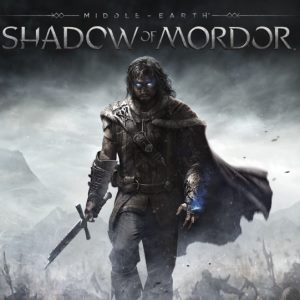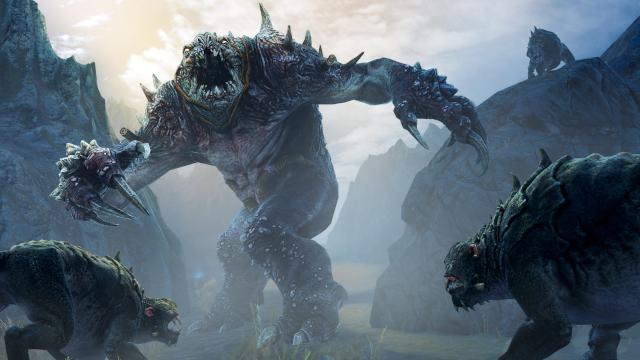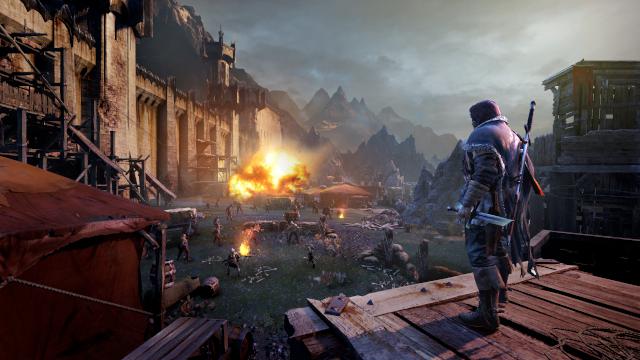
It’s been a long time since The Lord of the Rings came out on the big screen, and the mixture of quality from the games tied to the series has left gamers never quite sure what to expect. Many games have tried and done well, many have done a merely reasonable job and many have made an utter hash of it, but with Shadow of Mordor something remarkable has happened: we’ve got an incredibly good Lord of the Rings game, and by far the best one I’ve played.
Set in the time between The Hobbit and The Lord of the Rings the game opens with a gruesome chunk of plot where Talion, a Gondor Ranger who you’ll be controlling throughout the game, and his family are brutally killed by Sauron’s army who have just returned to Middle-Earth. Sadly you’re banished from death and can’t join the rest of your family until you’ve killed the Black Hand of Sauron (the big guy who killed you), all the whole trying to figure out the history and identity of a ghostly Elven wraith who Talion is bound to until the whole affair has been sorted out.
Still with me? Marvellous.
Shadow of Mordor takes shape as a third person open world game which borrows heavily from several other titles to create a varied, large and extremely playable jaunt across Mordor. Combat is largely sword based and takes blatant inspiration from the Arkham and Assassin’s Creed methods of using timing, combos and counter-attacks to take on huge crowds of enemies at once without getting frustrating. With these inspirations being such excellent systems it’s no surprise how smooth and enjoyable these fights end up being, with all of the larger enemies having their own strengths and weaknesses to mix up how you approach or fight them. But if you think this is the end of the Ubisoft inspirations then think again – anyone who has played Far Cry 3 will feel at home with the open world mission structure, the tall towers which unlock nearby activities and the strongholds full of bad guys for you to sink your dagger into. The various systems come together in a way which allows you to recognise where the ideas have been plucked from, but still keeps an identity of its own and lets you enjoy the game for what it is.

A helpful part of this individuality is the way the Nemesis systems works, and it’s a moment of brilliance from the developers. Sauron’s army is mostly made up of Uruks, powerful orcs who fight to get to the top of the command chain and roam the land in groups of varying sizes. The Uruks work under a hierarchical system, constantly striving for underhand ways to become more powerful, more important and more feared. These orc officers act as mini boss fights, and can crop up at pretty much wherever you are in the open world – kill the bad guy and you’re awarded runes for your weapons, making you a far more devastating killing machine. The runes themselves fit into slots which you unlock on your sword, dagger and bow and with only a limited number allowed at once you’ll soon have enough to choose your own fighting style and how you want to balance your extra powers.
Meanwhile, Uruks will carry on with internal power struggles which affect how powerful various individuals are. Each officer is randomly generated with their name, personality, voice and appearance giving you your own set of enemies which, were you to play through a second time, you’d probably never hear from again. Knowing their strengths and weaknesses is often key to a fair fight (and also part of the random nature of the characters), and such intel can be picked up from grabbing a weakened opponent and reading their mind before killing them off. When you’re faced with a powerful Uruk in among a crowd of 20 others, it pays to know a quick and easy way to polish them off before one of the more insignificant orcs manages to stab you in the head.
And yet, getting killed opens up another awesome element to the Nemesis system, making it a genuinely worthwhile thing to do every now and then. Whichever bad guy manages to kill you gains importance within the Uruk ranks, gaining promotion and power while he does. This does several things, the most obvious being that this previously insignificant bottom-of-the-barrel orc (assuming for now it’s not an officer who killed you) now gets given a whole new random identity, giving the idea that every single one of the thousands of Uruks you’ll come across has their own preset name and personality. They don’t of course, they’re only important and assigned this information once they have a reason to have it, but the seamless nature of the Nemesis system makes you start to believe that every single one of your victims had their own background, fears and so on. The game also nudges you gently towards revenge, allowing you to easily mark your killer on the map for you to instantly hunt down and try to get your own back. You even get markers where your friends have been killed too, letting you hunt down the Uruk who got the better of your friend for you to go an avenge their death with some killing of your own. Meet an enemy for a second time (either while you’re seeking revenge or if you didn’t quite kill them first time round) and they’ll taunt you about how the last battle ended. If you injured them, they’ll potentially have extra armour covering up the injuries they sustained first time round. It gives the world a living, breathing feel which constantly evolves and changes around you, and while it can be quite aggravating to spend ages narrowly beating a chief only to find they’ve patched themselves up because you didn’t slice their head off, it does give a bigger feeling of accountability for how you carry out your fighting. They’ll even fight amongst themselves, with encounters that you can interfere with to influence which one wins and gains the power (or, if you’d rather, just kill both of them if you’re up to the job).

All this is wrapped in a massive amount of content, which populates your map bit by bit as you make progress and complete certain other objectives. There are stealthy missions which insist on you killing certain enemies or freeing slaves without being seen, tasks which involve you using your bow in various ways, moments when you’re just thrown into a group of quite angry Uruks and told to get on with it until they’ve all been killed, the list goes on. And these are just the side-missions, those extras which sit alongside the “boss” tasks away from the main story-based missions. As for that campaign, you’re free to choose your own route to a certain degree, where another nod towards Far Cry offers several possible options for which part of the story to complete next depending on which strand of the story you want to uncover before the others. Gollum makes an early appearance and leads you through many of these, with the identity of your mysterious ghostly company becoming clearer as the game moves on and proving a definite and understandable interest to Gollum himself.
There are tonnes of extras to find too, using your wraith abilities to unearth hidden treasures with backstories of their own, finding certain herbs which not only restore your health but also contribute towards survival challenges, and revealing sections of a large magical engraving hidden out of sight from those in the “real” Middle Earth. Completing various tasks awards points which accumulate to unlock skills on the skill tree, one which does away with pointless space-fillers and gives you solely useful skills which will soon become part of your arsenal. There’s so much to do that getting bored really isn’t an option, and with there being a good variety in the tasks you don’t feel like you’re doing the same thing for too long.
So the perfect game, right? Well it can feel like that at times, helped along by the fluid fighting system which relies on timing and well-judged counter attacks rather than mindless button mashing, but it gets quite tough when you find yourself next to a wall or in a doorway, at which point it’s not uncommon for the camera to decide the best view of the action is from the wrong side of the wall. It’s true of pretty much every open world game like this, but doesn’t make it any less annoying when it happens. The game also look gorgeous on the PS4, with a thoroughly consistent frame rate that stays solid even when you’re in the middle of a huge hoard of bad guys, but again there’s a flip side with how samey some areas are to others. The strongholds especially seem lacking in any kind of variety on the whole, although with no real world locations to draw on for inspiration this is sort of understandable.
But despite the occasional gripe there’s very little to criticise when looking at Shadow of Mordor. The Nemesis system is a master stroke and will surely be adopted by other games in the future (the Batman games could definitely utilise it) and pretty much every other element of the game is beautifully balanced and created to an excellent degree. It’s a massive statement of what can be done with modern gaming, and an experience that you really shouldn’t be missing out on.
Reviewed on PS4


Leave a Reply